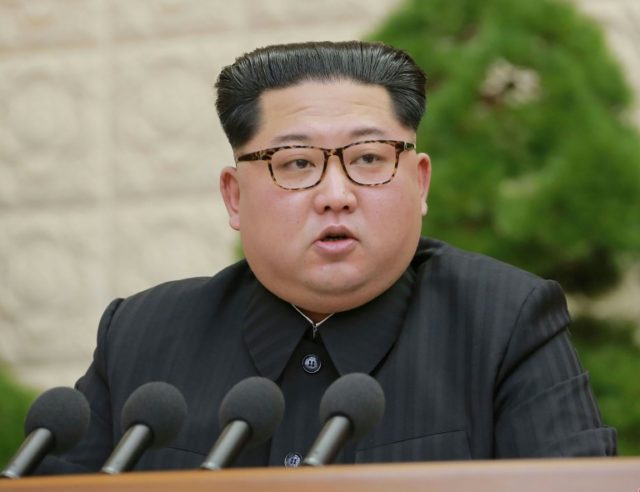Conflicting reports published early this week indicate that North Korea’s Punggye-ri Nuclear Test Site either remains “fully operational” or simply no longer functions after the nation’s last nuclear test, but has not been voluntarily shut down.
The North Korean government announced to the world Friday that it would suspend its nuclear weapons program, though it did not provide a timeframe for doing so or vow to do so permanently. Communist dictator Kim Jong-un is scheduled to meet South Korean President Moon Jae-in on Friday on his first trip to South Korea, and talks continue to confirm a date for his planned meeting with American President Donald Trump in late May or early June.
The conservative-leaning South Korean newspaper Chosun Ilbo reported Monday that some experts believe the nuclear test site suffered irreversible damage during the nation’s latest nuclear test in September 2017.
“As a result of the six nuclear tests from 2006 until last September, experts believe the Punggye-ri test site is now so unsafe and the ground so unstable that no further tests can be conducted there,” Chosun reported.
Hong Tae-kyung, a professor at Yonsei University, told the newspaper that the Punggye-ri site has experienced “a total of 10 earthquakes over magnitude 2.5, which were believed to have resulted from the collapse of tunnels” between the time of the last nuclear test and February.
“The Punggye-ri site is like a useless sacrificial stone in a baduk or go game. The North isn’t really giving up anything of value,” Prof. Nam Sung-wook of Korea University added in remarks to the newspaper.
While North Korea does not allow any international scrutiny of its nuclear testing site, observers who monitor satellite images and receive clandestine information from inside the country have long suspected that the site’s state has been precarious for months. In October, Japanese media reported a major tunnel collapse at the site, which reportedly killed 200 people. The North Korean government has neither confirmed nor mentioned the report at all.
The incident reportedly occurred while laborers were building a new tunnel for further testing, potentially as a result of the hollowing out of the mountain used for nuclear testing by other bombs.
The Punggye-ri Nuclear Test Site is located inside Mount Mantap, about 383 miles from Pyongyang and only 67 miles from the Chinese border. Satellite images published in the past appear to show significant damage to the mountain occurring as a result of nuclear testing and subsequent earthquakes, in particular landslides. North Korea recently lowered its troop presence around the site.
The website 38 North, which tracks North Korean nuclear activity, reported Tuesday that reports of damage shutting down activity at the Punggye-ri site are incorrect, and that Pyongyang has kept the site “fully operational.” While indicators seem to show that one of the tunnels used for testing “has been abandoned,” the site boasts other areas where tunneling as continued and could easily create space for new tests, the 38 North report claims.
“There is no basis to conclude that the Punggye-ri nuclear test site is no longer viable for future nuclear testing,” the report concluded. “There remain two portal areas located in more pristine competent rock that can be used for future tests if Pyongyang were to give the order. Whether that will stay an option will depend on reaching verifiable agreements that build on Pyongyang’s pledge to shut down the facility.”
Whether North Korea is serious about shutting down its nuclear program remains the major diplomatic point on which all productive talks planned for the future hinge. Denuclearization is expected to be at the core of the conversation between Moon Jae-in and Kim Jong-un on Friday, which the leaders agreed to broadcast live, at least to South Korea.
On Friday, South Korean news outlets reported that the Korean Central News Agency (KCNA) had announced that “from April 21, North Korea will stop nuclear tests and launches of intercontinental ballistic missiles.”
“The North will shut down a nuclear test site in the country’s northern side to prove the vow to suspend nuclear test,” the announcement concluded.
It remains unclear whether North Koreans received this broadcast, or whether KCNA published it only to the outside world. Rodong Sinmun, the nation’s state publication, reported on the meeting in which the vow to denuclearize reportedly occurred—the Third Plenary Meeting of the Seventh Central Committee of the Workers’ Party of Korea—in a column on Tuesday, but did not specify any policy discussions taking place there. North Korea’s English-language media outlets are largely blocked to the outside world, making it difficult to follow what information is actually available to North Koreans.
At that meeting, Kim Jong-un “proudly declared the great victory of the line of simultaneously pushing forward the economic construction and the building of nuclear force and advanced a new strategic line,” Rodong Sinmun reported.
In remarks appearing to allude to the end of the nuclear program, the article stated, “The historic tasks, laid down in the line, were successfully carried out and, after all, the arduous struggle of the Korean people to acquire a powerful treasured sword for defending peace came to successful conclusion.”
Rodong Sinmun reported that “an epoch-making milestone” occurred at the meeting, but did not say what it was.
How big of an impact such an announcement will make on the relationship between North Korea and the free world will heavily depend on whether the 38 North report is correct—that North Korea can restart its nuclear program at any time—or whether the experts speaking to Chosun are correct, and Punggye-ri involuntarily shut itself down.
Kim Jong-un reportedly told North Korean officials in a meeting in Pyongyang in March that “denuclearization” was father Kim Jong-il’s “dying wish,” though he did not specify at the time whether he meant the shutdown of North Korea’s nuclear weapons program by that comment, or the removal of U.S. nuclear assets from the region.

COMMENTS
Please let us know if you're having issues with commenting.